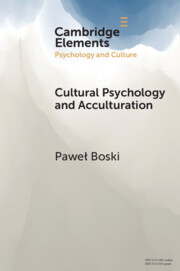503 results
Chapter 8 - Processing Speed and Cognitive Control
-
- Book:
- Cognitive Control along the Language Continuum
- Print publication:
- 27 June 2024, pp 117-132
-
- Chapter
- Export citation
3 - The Toronto Context
-
- Book:
- Heritage Languages
- Print publication:
- 27 June 2024, pp 29-36
-
- Chapter
- Export citation
Introduction
-
- Book:
- Cognitive Control along the Language Continuum
- Print publication:
- 27 June 2024, pp 1-4
-
- Chapter
- Export citation
Chapter 6 - The Impact of Language Input on Cognitive Control
-
- Book:
- Cognitive Control along the Language Continuum
- Print publication:
- 27 June 2024, pp 87-104
-
- Chapter
- Export citation
Individual differences in L2 proficiency moderate the effect of L1 translation knowledge on L2 lexical retrieval
-
- Journal:
- Bilingualism: Language and Cognition , First View
- Published online by Cambridge University Press:
- 04 June 2024, pp. 1-12
-
- Article
-
- You have access
- Open access
- HTML
- Export citation
1 - Language Acquisition
-
- Book:
- A Practical Guide to Second Language Teaching and Learning
- Published online:
- 03 May 2024
- Print publication:
- 30 May 2024, pp 1-21
-
- Chapter
- Export citation
Moving to continuous classifications of bilingualism through machine learning trained on language production
-
- Journal:
- Bilingualism: Language and Cognition , First View
- Published online by Cambridge University Press:
- 24 May 2024, pp. 1-9
-
- Article
-
- You have access
- Open access
- HTML
- Export citation
Understanding the impact of foreign language on social norms through lies
-
- Journal:
- Bilingualism: Language and Cognition , First View
- Published online by Cambridge University Press:
- 23 May 2024, pp. 1-15
-
- Article
-
- You have access
- Open access
- HTML
- Export citation
Bilingualism and flexibility in task switching: A close replication study
-
- Journal:
- Studies in Second Language Acquisition , First View
- Published online by Cambridge University Press:
- 23 May 2024, pp. 1-17
-
- Article
-
- You have access
- Open access
- HTML
- Export citation
31 - Heritage Language Forms
- from Part 5 - Sociolinguistic and Geographical Approaches
-
-
- Book:
- The Cambridge Handbook of Slavic Linguistics
- Published online:
- 16 May 2024
- Print publication:
- 23 May 2024, pp 657-674
-
- Chapter
- Export citation
What makes a cognate? Implications for research on bilingualism
-
- Journal:
- Bilingualism: Language and Cognition , First View
- Published online by Cambridge University Press:
- 14 May 2024, pp. 1-6
-
- Article
-
- You have access
- Open access
- HTML
- Export citation
Screening for Cognitive Impairment in Bilinguals: What Is the Influence of the Language of Assessment?
-
- Journal:
- Canadian Journal of Neurological Sciences , First View
- Published online by Cambridge University Press:
- 03 May 2024, pp. 1-6
-
- Article
- Export citation
The word frequency effect in first- and second-language reading by Chinese and Dutch bilinguals
-
- Journal:
- Bilingualism: Language and Cognition , First View
- Published online by Cambridge University Press:
- 03 May 2024, pp. 1-16
-
- Article
-
- You have access
- Open access
- HTML
- Export citation
BILINGUALISM AND GREEK IDENTITY IN THE FIFTH CENTURY b.c.e.
-
- Journal:
- The Classical Quarterly , First View
- Published online by Cambridge University Press:
- 30 April 2024, pp. 1-18
-
- Article
-
- You have access
- Open access
- HTML
- Export citation
Activation of ASL signs during sentence reading for deaf readers: evidence from eye-tracking
-
- Journal:
- Bilingualism: Language and Cognition , First View
- Published online by Cambridge University Press:
- 26 April 2024, pp. 1-9
-
- Article
-
- You have access
- Open access
- HTML
- Export citation
Bilinguals on the footbridge: the role of foreign-language proficiency in moral decision making
-
- Journal:
- Bilingualism: Language and Cognition , First View
- Published online by Cambridge University Press:
- 25 April 2024, pp. 1-16
-
- Article
-
- You have access
- Open access
- HTML
- Export citation
Executive function's structure in monolingual and bilingual adults using confirmatory factor analysis
-
- Journal:
- Bilingualism: Language and Cognition , First View
- Published online by Cambridge University Press:
- 25 April 2024, pp. 1-11
-
- Article
-
- You have access
- Open access
- HTML
- Export citation
Bilingualism and ageing independently impact on language processing: evidence from comprehension and production
-
- Journal:
- Bilingualism: Language and Cognition , First View
- Published online by Cambridge University Press:
- 12 April 2024, pp. 1-15
-
- Article
-
- You have access
- Open access
- HTML
- Export citation

Cultural Psychology and Acculturation
-
- Published online:
- 15 March 2024
- Print publication:
- 09 May 2024
-
- Element
- Export citation
Bilingual proficiency effects in paired-associate learning of vocabulary in an unfamiliar language
-
- Journal:
- Bilingualism: Language and Cognition , First View
- Published online by Cambridge University Press:
- 07 March 2024, pp. 1-18
-
- Article
-
- You have access
- Open access
- HTML
- Export citation



